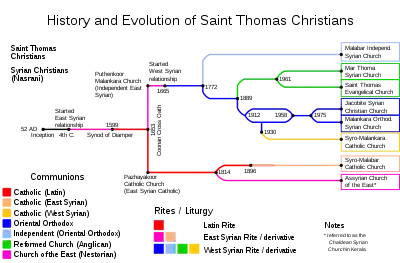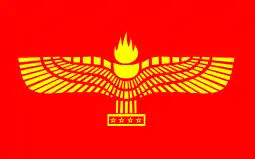Chaldean Catholics
Chaldean Catholics (/kælˈdiːən/) (Syriac: ܟܲܠܕܵܝܵܐ ܩܲܬܘܿܠܝܼܩܵܝܵܐ),[1] also known as Chaldeans (Syriac: ܟܠܕܝ̈ܐ or ܟܲܠܕܵܝܹܐ, Kaldāye)[6][7][8] or Chaldo-Assyrians or Assyro-Chaldeans,[9] are ethnic Assyrians[10][11] who adhere to the Chaldean Catholic Church, which originates from the historic Church of the East.[12]
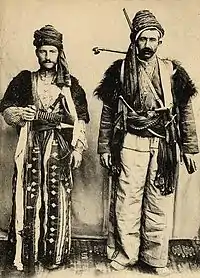 Chaldean Catholics from Mardin, 19th century. | |
| Total population | |
|---|---|
| 616,639 (2018)[2] | |
| Regions with significant populations | |
| Assyrian homeland | 300,000+ |
| 241,471 (2016)[3] | |
| 48,594 (2016)[3] | |
| 10,000 (2016)[3] | |
| 3,390 (2016)[3] | |
| Assyrian diaspora | 300,000+ |
| 250,000 (2018)[4] | |
| 31,372 (2016)[3] | |
| 17,172 (2016)[5] | |
| Religions | |
| Chaldean Catholic Church | |
| Scriptures | |
| The Bible | |
| Languages | |
| Neo-Aramaic (Assyrian, Chaldean, Turoyo) | |
Chaldean Catholics, while being ethnic Assyrians or Chaldo-Assyrians or Assyro-Chaldeans, are distinct from Assyrians in the sense of adherents of the Assyrian Church of the East, who are also spoken of as Assyrians.[13][14]
Other Christian denominations present in Iraq include the Assyrian Church of the East and the Ancient Church of the East (both of which also originate from the historic Church of the East and are now much less numerous than the Chaldean Catholic Church),[15] the Syriac Orthodox Church and the Syriac Catholic Church.[16] Chaldeans and Assyrians are also recognized as distinct nationalities by the Iraqi Constitution.[17]
The Chaldean Catholic community was formed in Upper Mesopotamia in the 16th and 17th centuries, arising from groups of the Church of the East who, after the schism of 1552, entered communion with the Holy See (the Catholic Church). Indigenous to the region of north Iraq, southeast Turkey and northeast Syria, many have migrated to Western countries including the United States, Canada, Mexico, Australia, Sweden and Germany. Many of them also live in Lebanon, Egypt, Palestine, Israel, Jordan, Iran, Turkey, and Georgia. The most recent reasons for migration are religious persecution, ethnic persecution, poor economic conditions during the sanctions against Iraq, and poor security conditions after the 2003 invasion of Iraq.
Identity and names
Followers of the Chaldean Catholic Church often identify and are identified as "Chaldean" but, like adherents of the Syriac Orthodox Church, Syriac Catholic Church, Assyrian Church of the East and Ancient Church of the East who also live in or originate from Upper Mesopotamia, they call themselves Suraye in their own language (Syriac: ܣܘܪܝܐ). When their community entered communion with Rome, the Catholic Church called them, as before, Chaldeans, prohibiting the use for them of the description "Nestorians",[18][19][20] reserving the latter term for followers of the Church of the East who were not in communion. The name "Chaldean" applied to both branches, and is still in use for the Chaldean Syrian Church in India, which is in union with the Assyrian Church of the East.[21]
In 1908, before the Seyfo genocide, the dissolution of the Ottoman Empire and the creation in the Middle East of new states such as Iraq, an article in the Catholic Encyclopedia could say that "in Chaldea proper, apart from Baghdad, there are now very few adherents of this rite, most of the Chaldean population being found in the cities of Kirkuk, Erbil, and Mosul, in the heart of the Tigris valley, in the valley of the Zab, and in the mountains of Kurdistan. It is in the former ecclesiastical province of Ator (Assyria) that are now found the most flourishing of the Catholic Chaldean communities. The native population accepts the name of Atoraya-Kaldaya (Assyro-Chaldeans), while in the neo-Syriac vernacular Christians generally are known as Syrians."[22] The consequent upheaval produced both an exodus, in particular but not only from what is now Turkey, to other countries and, within Iraq, a mainly urbanized Chaldean Church.[23][24]
Kurdish organizations often refer to local Christians as Kurdish Christians. Some Assyrians in the north of Iraq supported Kurdish military and political activities in order to "advance the cause of Assyrian nationalism" and "sought to control the discourse on nomenclature among the Christian communities utilising 'Assyrian' as a suitable title for all Christians so that the supposed link to the Assyrian people of the Ancient World could be maintained and give credence to their agitation for an independent state".[25] The Assyrian Democratic Movement proposed to refer to the Christian population as "Chaldo-Assyrian",[26] a political appellation from which the Chaldean Church soon withdrew support.[27][28]
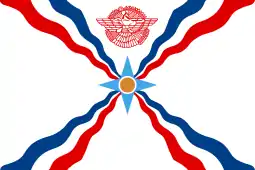
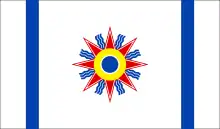
Raphael I Bidawid, patriarch of the Chaldean Catholic Church from 1989 to 2003 was quoted, after his death, in issue 55/3 (Fall 2003) of the Assyrian Star, as having said:
- "I personally think that these different names serve to add confusion. The original name of our Church was the ‘Church of the East’ … When a portion of the Church of the East became Catholic in the 17th Century, the name given was ‘Chaldean’ based on the Magi kings who were believed by some to have come from what once had been the land of the Chaldean, to Bethlehem. The name ‘Chaldean’ does not represent an ethnicity, just a church… We have to separate what is ethnicity and what is religion… I myself, my sect is Chaldean, but ethnically, I am Assyrian."[29]
Before becoming Chaldean patriarch, he was quoted in the September–October 1974 issue of the Assyrian Star as saying in an interview:
- "Before I became a priest I was an Assyrian, before I became a bishop I was an Assyrian, I am an Assyrian today, tomorrow, forever, and I am proud of it."[30]
In 2008, his successor, Emmanuel III Delly was quoted as saying in an interview on 27 October 2008:
- "I would like to state that we, the Chaldean, Assyrian and Syrian people are one people known as Aramean people. Let Iraq continue to live with all its ethnic groups, Arabs, Kurds, Arameans, Yazidis, Mandaeans and Shabaks."[31]
In 2017, the Chaldean Catholic Church issued an official statement of its Synod of Bishops, the body that is exclusively competent to make laws for the entire church and that is its tribunal,[32] It said it sets store on the distinct Chaldean identity, which is recognized in the Constitution of Iraq, and declared:
- "As a genuine Chaldean people, we officially reject the labels that distort our Chaldean identity, such as the composite name “Chaldean Syriac Assyrian” used in the Kurdistan Region, contrary to the name established in the Iraqi constitution.[17] We call upon our daughters and sons to reject these labels, to adhere to their Chaldean identity without fanaticism, and to respect the other names such as ‘Assyrians’, ‘Syriacs’, and ‘Armenians’. We call upon the authorities in the region to respect them, and we encourage our Chaldeans to cooperate with everyone for the common good and not to split into unidentified groups or follow illusory projects that harm Christians. We also encourage them to engage in public affairs and in the political process as genuine partners of this blessed land, and to play their role alongside their fellow citizens in building a modern and strong civil country that befits their country’s civilization and glory, a country that respects the rights and equality of all. We also express our support for the Chaldean League which seeks to establish links between the Chaldeans around the world."[33]
Population
There were 640,828 adherents of the Chaldean Catholic Church worldwide according to the 2016 Annuario Pontificio.[3]
Iraq
Chaldeans are mentioned in Article 125 of the Iraqi constitution as a nationality distinct from the Turkomen and the Assyrians.[17]
In northern Iraq, the Chaldean Catholic community inhabits Alqosh, Ankawa, Araden, Baqofah, Batnaya, Karamles, Mangesh, Shaqlawa, Tesqopa, Tel Keppe, and Zakho.
The Chaldean Catholic Church is the largest church in Iraq.[12]
Syria, Turkey and Iran
In Syria, Chaldean Catholics number 10,000; in Turkey, 48,594; and in Iran, 3,390.[3]
Diaspora
In Southeast Michigan there is a Chaldean Catholic community numbering 113,000 people.[34] This is the largest Chaldean Catholic diaspora community outside Iraq.[34] Members are Arabic- or Aramaic-speaking.[34]
A small number of Chaldean Catholic families live in Israel and the Palestinian territories. Occasionally the Chaldean Patriarchate has tried to administer them through the Chaldean street residence of a currently vacant Chaldean Patriarchal Exarch in Jerusalem.[35]
History and origin
The Chaldean community originates from groups of adherents of the Church of the East that entered into communion with the Roman Catholic Church in the 16th and 17th centuries.[36][37] The community emerged after the schism of 1552.[38] These "Nestorian" Uniates received the name "Chaldeans" from the Roman Curia, which had given the ancient name Chaldaei to them.[39]
The term Chaldean, used in reference to members of the Chaldean Catholic Church, arose in the mid-15th century.[40] Previously, it was used in reference to the Church of the East, which, because it rejected the Council of Ephesus (431), was called Nestorian.[41]
Neither before nor after the 15th century did the term "Chaldean" indicate a supposed ethnic connection of the Church of the East with ancient south Babylonian Chaldea and its inhabitants, which emerged during the 9th century BC after Chaldean tribes migrated from the Levant region of Urfa in North Mesopotamia to southeast Mesopotamia, and disappeared from history during the 6th century BC:[42] it referred instead to the use by Christians of that church of the Syriac language, a form of the biblical Aramaic language, which was then and indeed until the 19th century generally called Chaldean.[43][44][45][46] The Chaldean Catholics originated from ancient communities living in and indigenous to the north of Iraq/Mesopotamia, once known as Assyria (from the 25th century BC until the 7th century AD).[47][30][48] Chaldean Catholics largely bear the same family and personal names, share the same genetic profile, hail from the same villages, towns and cities in northern Iraq, southeast Turkey, northeast Syria and northwest Iran, as their neighbours of other religious denominations.[42] The Chaldean Neo-Aramaic, Assyrian Neo-Aramaic and Surayt/Turoyo languages do not run parallel to the often associated religious denominations (Chaldean Catholic Church, Assyrian Church of the East, Syriac Orthodox Church).
The term "Chaldean" continued to apply to all who were of the Church of the East tradition, whether they were or were not in communion with Rome. Throughout the 19th century it continued to be used of East Syriac Christians, whether "Nestorian" or Catholic,[49][50][51][52][53] and this usage continued into the 20th century.[54] In 1852 George Percy Badger distinguished those whom he called Chaldeans from those whom he called Nestorians, but by religion alone, never by language, race or nationality.[55]
20th century
According to a 1950 CIA report on Iraq, Chaldeans numbered 98,000 and were the largest Christian minority.[56]
A 1950 CIA report on Iraq estimated 98,000 Chaldeans, 30,000 Nestorians, 25,000 Syriac Catholics and 12,000 Syriac Orthodox Christians.
21st century
In 2019, the United States Commission on International Religious Freedom, reported that, according to the Iraqi Christian Foundation, an agency of the Chaldean Catholic Church, approximately 80% of Iraqi Christians were of that Church.[57] In its own 2018 Report on Religious Freedom, the U.S. Department of State put the Chaldean Catholics at approximately 67% of the Christians in Iraq.[58] The 2019 Country Guidance on Iraq of the European Asylum Support Office gve the same information as the U.S. Department of State.[59]
According to estimates by the Catholic Church, in Chaldean dioceses in Iraq there were 150,000 Catholics in the Archdiocese of Baghdad (2015),[60] 30,000 in the Archeparchy of Arbil (2012),[61] 22,300 in the Diocese of Alqosh (2012),[62] 18,800 in the Diocese of Amadiyah and Zakho (2015),[63] 14,100 in the Archeparchy of Mosul (2013),[64] 7,831 in the Archdiocese of Kirkuk (2013),[65] 1,372 in Diocese of Aqrā (2012),[66] 800 in Archeparchy of Basra (2015),[67]
Condition of the Chaldean Catholic Church
The 1896 census of the Chaldean Catholics[68] counted 233 parishes and 177 churches or chapels, mainly in northern Iraq and southeastern Turkey. The Chaldean Catholic clergy numbered 248 priests; they were assisted by the monks of the Congregation of St. Hormizd, who numbered about one hundred. There were about 52 Assyrian Chaldean schools (not counting those conducted by Latin nuns and missionaries). At Mosul there was a patriarchal seminary, distinct from the Chaldean seminary directed by the Dominicans. The total number of Assyrian Chaldean Christians as by 2010 was 490,371,[3] 78,000 of whom are in the Diocese of Mosul.
The current patriarch considers Baghdad as the principal city of his see. His title of "Patriarch of Babylon" results from the identification of Baghdad with ancient Babylon (however Baghdad is 55 miles north of the ancient city of Babylon and corresponds to northern Babylonia). However, the Chaldean patriarch resides habitually at Mosul in the north, and reserves for himself the direct administration of this diocese and that of Baghdad.
There are five archbishops (resident respectively at Basra, Diyarbakır, Kirkuk, Salmas and Urmia) and seven bishops. Eight patriarchal vicars govern the small Assyrian Chaldean communities dispersed throughout Turkey and Iran. The Chaldean clergy, especially the monks of Rabban Hormizd Monastery, have established some missionary stations in the mountain districts dominated by The Assyrian Church of the East. Three dioceses are in Iran, the others in Turkey.
The liturgical language of the Chaldean Catholic Church is Syriac and the liturgy of the Chaldean Church is written in the Syriac alphabet. The literary revival in the early 20th century was mostly due to the Lazarist Pere Bedjan, an ethnic Assyrian Chaldean Catholic from northwestern Iran. He popularized the ancient chronicles, the lives of Assyrian saints and martyrs, and even works of the ancient Assyrian doctors among Assyrians of all denominations, including Chaldean Catholics, Syriac Orthodox, Assyrian Church of the East and Assyrian Protestants.[69]
In 2016, Chaldean Catholics numbered approximately 400,000[3] of Iraq's Christians, with smaller numbers found among Christian communities of northeast Syria, southeast Turkey, northwest Iran, Lebanon, Jordan, Israel, Georgia and Armenia. In 2008 the Catholics were still about 550,000, forming the majority of Iraq's estimated 700,000 Christians, but all Iraqi Christians were under attack by Sunni extremists in the wake of the 2003 Gulf War invasion and it was estimated that 60,000 Christians had by then fled the country.[70] Perhaps the best known Iraqi Chaldean Catholic was Deputy Prime Minister (1979–2003) and Foreign Minister (1983–1991) Tariq Aziz.[70]
By 2012, hundreds of thousands of Christians of all denominations left Iraq after the ousting of Saddam Hussein. At least 20,000 of them fled through Lebanon to seek resettlement in Europe and the US.[71] In March 2008, Chaldean Catholic Archbishop Paulos Faraj Rahho of Mosul was kidnapped, and found dead two weeks later. Pope Benedict XVI condemned his death. Sunni and Shia leaders also expressed their condemnation.[72] As political changes sweep through many Arab nations, the ethnic Assyrian minorities throughout the Middle East have expressed concern about the developments and their future in the region.[73]
Organizations
- Parties
- Chaldean Democratic Union, Chaldean Christian democratic party in Iraq
- Chaldean Syriac Assyrian Popular Council, joint Chaldean-Syriac-Assyrian democratic party in Iraq
- Militia
Notable people
- Mark Arabo[74] – Chaldean-American spokesman for Christians in Iraq[75]
- Tariq Aziz[76]
- Paul Bedjan[77]
- Anna Eshoo[78][79]
- Hala Y. Jarbou[80]
- Justin Meram[81][82]
- Randa Markos[83][84]
- Mona Hanna-Attisha[85]
See also
References
- "ܣܝܡܝܕܐ ܕܬܠܬܐ ܟܗܢܐ ܓܘ ܡܕܝܢܿܬܐ ܕܥܢܟܒ̣ܐ ܕܐܪܩ" (in Syriac).
- Eastern Catholic Churches Worldwide 2018
- CNEWA 2016.
- Eastern Catholic Churches in the United States 2018
- "2016 Census QuickStats: Fairfield (NSW)". quickstats.censusdata.abs.gov.au.
- Allen James Fromherz. Gulf in World History: Arabian, Persian and Global Connections. Edinburgh University Press; 31 July 2018. ISBN 978-1-4744-3068-5. p. 106.
- Eleanor Coghill. The Rise and Fall of Ergativity in Aramaic: Cycles of Alignment Change. OUP Oxford; 5 September 2016. ISBN 978-0-19-103574-6. p. 114.
- Alexandre Salim Hourani, Ethnic, Political and Administrative Geography of the Biqāʽ, Wādī Al-Taym and ʻArqūb in the Greco-Roman Period. American University of Beirut. November 2006. p. 8
- James F. Coakley, "Assyrians" in Gorgias Encyclopedic Dictionary of the Syriac Heritage: Electronic Edition, edited by Sebastian P. Brock, Aaron M. Butts, George A. Kiraz and Lucas Van Rompay quote: Among Chaldean Catholics, ‘Assyrian’ has had to compete with ‘Chaldean’ as the preferred ethnic name. Some have adopted ‘Assyro-Chaldean’ as a compromise.
- For use of the term Chaldean, see:
- John A. Shoup, Ethnic Groups of Africa and the Middle East: An Encyclopedia, p. 30
- Nicholas Aljeloo, Who Are The Assyrians?
- Mordechai Nisan, Minorities in the Middle East: A History of Struggle and Self-Expression, p. 180
- Steven L. Danver, Native Peoples of the World: An Encyclopedia of Groups, Cultures and Contemporary Issues, p. 517
- "Iraq: Chaldean Christians". Refworld. June 27, 2000.
Chaldean and Assyrian Christians have the same ethnic and linguistic background, though as Eastern Rite Catholics, Chaldeans recognize the primacy of the Roman Catholic Pope while Assyrian Christians, who are not Catholic, do not
- "Who are the Chaldean Christians?". BBC News. March 13, 2008. Retrieved March 26, 2010.
- Yasmeen Hanoosh. The Chaldeans: Politics and Identity in Iraq and the American Diaspora. Bloomsbury Publishing; 30 May 2019. ISBN 978-1-78673-600-0. pp. 41, 91 et passim.
- Nadia Jones-Gailani. Transnational Identity and Memory Making in the Lives of Iraqi Women. University of Toronto Press; 20 August 2020. ISBN 978-1-4875-0316-1. p. 50.
- In its 2018 Report on Religious Freedom, the U.S. Department of State put the Chaldean Catholics at approximately 67% of the Christians in Iraq (Iraq 2018 International Religious Freedom Report, p. 3). The 2019 Country Guidance on Iraq of the European Asylum Support Office gives the same information as the U.S. Department of State (European Asylum Support Office: Country Guidance - Iraq (June 2019), p. 70). Note that the Chaldean numbers are compared not only to the other two churches originating from the Church of the East but also to those of West Syriac tradition.
- Kristian Girling, "'To live within Islam': The Chaldean Catholic Church in Modern Iraq, 1958–2003" in Charlotte Methuen, Andrew Spicer, John Wolffe (editors), Christianity and Religious Plurality (The Ecclesiastical History Society 2015), p. 370
- "Iraq's Constitution of 2005, article 125" (PDF). Retrieved September 10, 2020.
- "Council of Basel-Ferrara-Florence, 1431-49 A.D.
- Wilhelm Braun, Dietmar W. Winkler, The Church of the East: A Concise History (RoutledgeCurzon 2003), p. 112
- Michael Angold; Frances Margaret Young; K. Scott Bowie (17 August 2006). The Cambridge History of Christianity: Volume 5, Eastern Christianity. Cambridge University Press. p. 527. ISBN 978-0-521-81113-2.
- "CHURCH OF THE EAST – INDIA". churchoftheeastindia.org.
- Jérôme Labourt, "Chaldean Christians" in The Catholic Encyclopedia (New York 1908). Retrieved 6 September 2020.
- Yasmeen Hanoosh. The Chaldeans: Politics and Identity in Iraq and the American Diaspora. Bloomsbury Publishing; 30 May 2019. ISBN 978-1-78672-596-7. p. 149 et passim.
- Richard T. Schaefer. Encyclopedia of Race, Ethnicity, and Society. SAGE; 20 March 2008. ISBN 978-1-4129-2694-2. p. 160.
- F. Christian Girling, The Chaldean Catholic Church: A study in modern history, ecclesiology and church-state relations (2003–2013) (Heythrop College, University of London 2015), pp. 122–123
- Karl R. DeRouen; Paul Bellamy (2008). International Security and the United States: An Encyclopedia. Greenwood Publishing Group. p. 366. ISBN 978-0-275-99254-5.
- Gregory J. Kruczek, "Christian Minorities and the Struggle for Nineveh: The Assyrian Democratic Movement and the Nineveh Plains Protection Units" p. 81
- Girling, The Chaldean Church (205), p. 148]
- Parpola, Simo (2004). "National and Ethnic Identity in the Neo-Assyrian Empire and Assyrian Identity in Post-Empire Times" (PDF). Journal of Assyrian Academic Studies. JAAS. 18 (2): 22. Archived from the original (PDF) on 2011-07-17. Retrieved 2014-09-26.
- Mar Raphael J Bidawid. The Assyrian Star. September–October, 1974:5.
- "Patriarch Emmanuel Delly of the Chaldean Church of Babylon in Iraq affirms the Aramean origin of the Iraqi Christians". Access-date=7 September 2020
- Code of Canons of the Eastern Churches, canon 110; English translation
- [Statement of the Synod of the Chaldean Church Bishops held in Rome 4-8 October 2017, published on the website of the Catholic Patriarchate of Babylon]
- Robson 2016, p. 267.
- Eldar, Yishai. "Focus on Israel: The Christian Communities of Israel". Israeli Ministry of Foreign Affairs. Retrieved August 25, 2020.
The Chaldean Catholic Church is a uniate descendant of the ancient (Assyrian) Apostolic Church of the East (sometimes called Nestorian). Its members still preserve the use of Syriac (Eastern Aramaic) as their liturgical language. It was established in 1551, and its patriarch is resident in Baghdad. The community in the Holy Land numbers no more than a few families; even so, the Chaldean Catholic Church retains the status of a "recognized" religious community. Since 1903, the Chaldeans have been represented in Jerusalem by a non-resident patriarchal vicar.
- Berg 2009, pp. 155–.
- Wilhelm Baum; Dietmar W. Winkler (8 December 2003). The Church of the East: A Concise History. Routledge. pp. 119–. ISBN 978-1-134-43019-2.
- George V. Yana (Bebla) (2000). "Myth vs. Reality". JAA Studies. XIV (1): 80.
- Becker, p. 302.
- Coakley, J. F. (2011). Brock, Sebastian P.; Butts, Aaron M.; Kiraz, George A.; van Rompay, Lucas (eds.). Chaldeans. Gorgias Encyclopedic Dictionary of the Syriac Heritage. Piscataway, NJ: Gorgias Press. p. 93. ISBN 978-1-59333-714-8.
- Wilhelm Braun, Dietmar W. Winkler, The Church of the East: A Concise History (RoutledgeCurzon 2003), p. 83
- Travis 2010.
- Edmon Louis Gallagher (23 March 2012). Hebrew Scripture in Patristic Biblical Theory: Canon, Language, Text. BRILL. pp. 123, 124, 126, 127, 139. ISBN 978-90-04-22802-3.
- Julius Fürst (1867). A Hebrew and Chaldee Lexicon to the Old Testament: With an Introduction Giving a Short History of Hebrew Lexicography. Tauchnitz.
- Wilhelm Gesenius; Samuel Prideaux Tregelles (1859). Gesenius's Hebrew and Chaldee Lexicon to the Old Testament Scriptures. Bagster.
- Benjamin Davies (1876). A Compendious and Complete Hebrew and Chaldee Lexicon to the Old Testament, Chiefly Founded on the Works of Gesenius and Fürst ... A. Cohn.
- Parpola, Simo (2004). "National and Ethnic Identity in the Neo-Assyrian Empire and Assyrian Identity in Post-Empire Times" (PDF). Journal of Assyrian Academic Studies (JAAS) 18 (2): 22.
- Nisan 2002, p. ?.
- Ainsworth, William (1841). "An Account of a Visit to the Chaldeans, Inhabiting Central Kurdistán; and of an Ascent of the Peak of Rowándiz (Ṭúr Sheïkhíwá) in Summer in 1840". The Journal of the Royal Geographical Society of London. 11. e.g. p. 36. doi:10.2307/1797632. JSTOR 1797632.
- William F. Ainsworth, Travels and Researches in Asia Minor, Mesopotamia, Chaldea and Armenia (London 1842), vol. II, p. 272, cited in John Joseph, The Modern Assyrians of the Middle East (BRILL 2000), pp. 2 and 4
- Layard, Austen Henry (July 3, 1850). Nineveh and its remains: an enquiry into the manners and arts of the ancient assyrians. Murray. p. 260 – via Internet Archive.
Chaldaeans Nestorians.
- Simon (oratorien), Richard (July 3, 1684). "Histoire critique de la creance et des coûtumes des nations du Levant". Chez Frederic Arnaud – via Google Books.
- Rassam, Hormuzd (1897). Asshur and the land of Nimrod. Curts & Jennings. p. – via Internet Archive.
all the Chaldaeans, whether Nestorians or Papal.
- Ely Banister Soane, To Mesopotamia and Kurdistan in disguise : with historical notices of the Kurdish tribes and the Chaldeans of Kurdistan (Small, Maynard and Company 1914)
- George Percy Badger (1852). The Nestorians and Their Rituals: With the Narrative of a Mission to Mesopotamia and Coordistan in 1842-1844, and of a Late Visit to Those Countries in 1850: Also, Researches Into the Present Condition of the Syrian Jacobites, Papal Syrians, and Chaldeans, and an Inquiry Into the Religious Tenets of the Yezeedees. Joseph Masters. ISBN 9780790544823.
- "National Intelligence Survey: Iraq: Section 43" (PDF). CIA.
- Brief Summary on Iraqi Christians
- Iraq 2018 International Religious Freedom Report, p. 3
- European Asylum Support Office: Country Guidance - Iraq (June 2019), p. 70
- "Baghdad (Chaldean Archdiocese) [Catholic-Hierarchy]". catholic-hierarchy.org.
- "Arbil {Erbil} (Chaldean Archeparchy) [Catholic-Hierarchy]". catholic-hierarchy.org.
- "Alquoch (Chaldean Diocese) [Catholic-Hierarchy]". catholic-hierarchy.org.
- "Amadiyah and Zakho (Chaldean Diocese) [Catholic-Hierarchy]". catholic-hierarchy.org.
- "Mossul (Chaldean Archeparchy) [Catholic-Hierarchy]". catholic-hierarchy.org.
- "Kerkūk (Chaldean Archdiocese) [Catholic-Hierarchy]". catholic-hierarchy.org.
- "Aqrā {Akra} (Chaldean Diocese) [Catholic-Hierarchy]". catholic-hierarchy.org.
- "Bassorah {Basra} (Chaldean Archeparchy) [Catholic-Hierarchy]". catholic-hierarchy.org.
- Mgr. George 'Abdisho' Khayyath to the Abbé Chabot (Revue de l'Orient Chrétien, I, no. 4)
- "New Advent Catholic Encyclopedia".
- BBC 2008.
- Martin Chulov (2010) "Christian exodus from Iraq gathers pace"The Guardian. Retrieved June 12, 2012
- "Iraqi archbishop death condemned". BBC News. 2008-03-13. Retrieved 2009-12-31. from BBC News
- R. Thelen (2008) Daily Star, Lebanon retrieved June 12, 2012
- "Chaldeans criticize El Cajon's attitude". UTSanDiego.com. 2013-10-22. Retrieved 2014-05-02.
- Voice of San Diego
- "Minority Rights Group International : Iraq : Chaldeans". minorityrights.org. Archived from the original on 4 July 2014.
- Nemrod Simono, Paul Bedjan Biography, Tehran, 1984
- Brown, Lauretta (September 10, 2015). "Bipartisan Resolution Introduced: Persecution of Mideast Christians is 'Genocide'". CNS News. Retrieved August 20, 2020.
Eshoo is a Chaldean Catholic and first generation American, with an Armenian mother and Assyrian Christian father from Iraq.
- Congresswoman Anna Eshoo and denial of her Assyrian background on YouTube
- "Trump Nominates First Chaldean Assyrian for Federal Bench". March 13, 2020. Retrieved August 20, 2020.
- "Assyriska and What It Means to a Proud Community". February 15, 2016. Retrieved August 20, 2020.
Being the only Assyrian/Chaldean player on the team, I am playing for the whole country but always making our culture proud.
- Kay, Bryan. "'It was always my No1 choice': Justin Meram, the US-born Christian playing for Iraq". The Guardian. Retrieved August 19, 2020.
Right now, he is the lone Christian in the ranks, flying the flag for Iraq’s Chaldeans, an ancient Assyrian people who have called the region home since long before the time of Jesus.
- Huang, Michael (September 19, 2014). "Meet Randa Markos, the Assyrian Refugee-Turned-UFC Fighter". Retrieved August 19, 2020.
As a Chaldean (Iraqi Christian) family, Markos' upbringing remained traditional and strict. So she told her family she played volleyball instead, then she went off every day and grappled with the boys.
- UFC Randa Markos Interview at Assyrian Fighters Night on YouTube
- https://www.crainsdetroit.com/article/20180615/news/663671/dr-monas-new-book-tells-how-tide-turned-on-state-in-flint-water-crisis
Sources
- Baum, Wilhelm; Winkler, Dietmar W. (2003). The Church of the East: A Concise History. London-New York: Routledge-Curzon. ISBN 9781134430192.
- Chabot, Jean-Baptiste (1896). "Éttat religieux des diocèses formant le patriarcat chaldéen de Babylone". Revue de l'Orient chrétien. 1: 433–453.
- Joseph, John (2000). The Modern Assyrians of the Middle East: Encounters with Western Christian missions, archaeologists, and colonial power. BRILL. ISBN 978-90-04-32005-5.
- Lukitz, Liora (2005). Iraq: The Search for National Identity. Routledge. ISBN 978-1-135-77821-7.
- Laura Robson (18 May 2016). Minorities and the Modern Arab World: New Perspectives. Syracuse University Press. pp. 266–. ISBN 978-0-8156-5355-4.
- Travis, Hannibal (2010) [2007]. Genocide in the Middle East: The Ottoman Empire, Iraq, and Sudan. Durham, NC: Carolina Academic Press. pp. 237–77, 293–294. ISBN 9781594604362.
- Nisan, M. (2002). Minorities in the Middle East: A History of Struggle for Self Expression. Jefferson: McFarland & Company.
- "The Eastern Catholic Churches 2016. Source: Annuario Pontificio" (PDF). CNEWA. 2016. pp. 3–4.
- Kristian Girling (2017). The Chaldean Catholic Church: Modern History, Ecclesiology and Church-State Relations. Taylor & Francis. pp. 133–. ISBN 978-1-351-70674-2.
Further reading
- Natalie Henrich; Joseph Patrick Henrich (2007). Why Humans Cooperate: A Cultural and Evolutionary Explanation. Oxford University Press. ISBN 978-0-19-531423-6.
- Oussani, G., 1901. "The modern Chaldeans and Nestorians, and the study of Syriac among them". Journal of the American Oriental Society, 22, pp. 79–96.
- Hanoosh, Y.S., 2008. The politics of minority Chaldeans between Iraq and America. University of Michigan.
- Mary C. Sengstock (1999). Chaldean Americans: Changing Conceptions of Ethnic Identity. Center for Migration Studies. ISBN 978-1-57703-013-3.
- Mary C. Sengstock (2005). Chaldeans in Michigan. Michigan State University Press. ISBN 978-0-87013-742-6.
- Jacob Bacall (2014). Chaldeans in Detroit. Arcadia Publishing. ISBN 978-1-4671-1255-0.
- Suha Rassam (2005). Christianity in Iraq: Its Origins and Development to the Present Day. Gracewing Publishing. ISBN 978-0-85244-633-1.
- Murre-van den Berg, H., 2009. "Chaldeans and Assyrians: The Church of the East in the Ottoman Period". The Christian Heritage of Iraq, pp. 157–161.
- Alichoran, J., 1994. "Assyro-Chaldeans in the 20th Century: From Genocide to Diaspora". Journal of the Assyrian Academic Society, 8, pp. 45–79.
External links
| Wikimedia Commons has media related to Chaldean Catholics. |
- "Who are the Chaldean Christians?". BBC News. March 13, 2008. Retrieved March 26, 2010.
- The Chaldean Catholic Church
- Iraq: Chaldean Christians UNHCR
- Chaldean Christians in the Catholic Encyclopedia (1908)
![]() This article incorporates text from a publication now in the public domain: Herbermann, Charles, ed. (1913). Catholic Encyclopedia. New York: Robert Appleton Company. Missing or empty
This article incorporates text from a publication now in the public domain: Herbermann, Charles, ed. (1913). Catholic Encyclopedia. New York: Robert Appleton Company. Missing or empty |title= (help)


